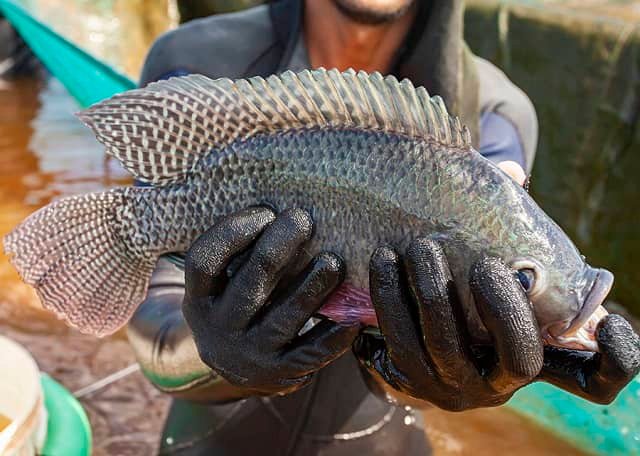
Streptococcosis is a highly feared disease in aquaculture due to its often fatal consequences and significant losses among fish farmers.
The neem tree, native to India and Myanmar, has been introduced to many countries worldwide because its extracts have medicinal uses and can be employed for insect control. In the soap industry, it replaces coconut oil, and it can also be used as an organic fertilizer.
Researchers from Zagazig University, King Saud University, and the University of Galway conducted a 90-day feeding trial with Nile tilapia (Oreochromis niloticus) to evaluate the effect of including Azadirachta indica seed protein hydrolysate (AIPH), also known as “Indian lilac,” “Indian margosa,” “neem,” in the diet.
The evaluation included the impact on growth metrics, economic efficiency, antioxidant potential, hematobiochemical indices, immune response, and histology.
The researchers used diets to feed the tilapia that included five levels of AIPH: 0%, 2%, 4%, 6%, and 8%, where the neem seed protein hydrolysate partially replaced fishmeal at 0%, 8.7%, 17.4%, 26.1%, and 34.8%, respectively.
After the feeding trial, the scientists intraperitoneally injected the fish with the pathogenic bacteria Streptococcus agalactiae and recorded the survival rate.
Neem improves growth
“The results clarified that diets including AIPH significantly improved growth indices (final body weight, total feed intake, total body weight gain, and specific growth rate) and intestinal morphometry compared to the control diet,” they reported.
They also highlighted that the diet including 8% neem seed protein hydrolysate registered the highest values.
Stay Always Informed
Join our communities to instantly receive the most important news, reports, and analysis from the aquaculture industry.
Cost reduction
On the other hand, the researchers reported that including Azadirachta indica seed protein hydrolysate in the tilapia diet significantly improved economic efficiency.
According to the researchers, economic efficiency is understood as a reduction in feed cost per kilogram gain and an increase in the yield index.
Improved protein profiles
“Fish fed with AIPH diets had higher protein profile variables and antioxidant capacities than the control group,” they reported.
They also noted that including Azadirachta indica in the diet significantly increased hematological parameters: hemoglobin, cell volume percentage, and red and white blood cell counts.
The researchers emphasized that immune indices also benefited in a concentration-dependent manner with AIPH.
Reduced mortality
“The mortality rate among fish infected with S. agalactiae decreased as AIPH levels in the diet increased, with the highest survival rate (86.67%) found in the AIPH8 group,” they noted.
Conclusion
The researchers reported that based on the discontinuous line regression model, the results suggest using an optimal level of 6% Azadirachta indica in Nile tilapia feeding.
“In general, the inclusion of AIPH in the diet improved growth rate, economic efficiency, health status, and resistance of Nile tilapia to S. agalactiae challenge,” they concluded.
Contact
Afaf N. Abdel Rahman and Rowida E. Ibrahim
Department of Aquatic Animal Medicine, Faculty of Veterinary Medicine
Zagazig University
PO Box 44511, Zagazig, Sharkia, Egypt.
Email: afne56@gmail.com and rowidakamhawey@yahoo.com
Reference
Abdel Rahman, A. N., Amer, S. A., Behairy, A., Younis, E. M., Abdelwarith, A. A., Osman, A., Moustafa, A. A., Davies, S. J., & Ibrahim, R. E. (2023). Using Azadirachta indica protein hydrolysate as a plant protein in Nile tilapia (Oreochromis niloticus) diet: Effects on growth, economic efficiency, antioxidant-immune response, and resistance to Streptococcus agalactiae. Journal of Animal Physiology and Animal Nutrition, 1–15. https://doi.org/10.1111/jpn.13857
Editor at the digital magazine AquaHoy. He holds a degree in Aquaculture Biology from the National University of Santa (UNS) and a Master’s degree in Science and Innovation Management from the Polytechnic University of Valencia, with postgraduate diplomas in Business Innovation and Innovation Management. He possesses extensive experience in the aquaculture and fisheries sector, having led the Fisheries Innovation Unit of the National Program for Innovation in Fisheries and Aquaculture (PNIPA). He has served as a senior consultant in technology watch, an innovation project formulator and advisor, and a lecturer at UNS. He is a member of the Peruvian College of Biologists and was recognized by the World Aquaculture Society (WAS) in 2016 for his contribution to aquaculture.




